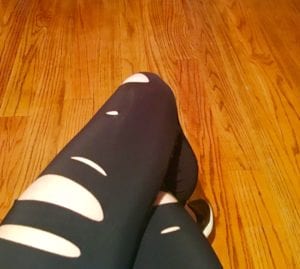Does crossing your legs cause spider veins? We'll get to that in a minute. First, we have to ask a different question. How many times a day do you look down and realize you've got crossed legs? Are you doing it right now? We’ve likely all heard that crossing your legs can be problematic, but do you know why? Or how long it takes for vein damage to set in? Here’s the low down on leg crossing.
To be clear: we can't prove that crossed legs cause spider veins. But while there hasn’t been conclusive proof to date, there seems to be a definite connection between crossing your legs and the appearance of varicose veins. The connection seems to be a result of pressure: varicose veins develop when veins are over-tasked. And resting one leg on the other can restrict blood flow, causing extra blood to pool and stretch out the over-worked veins.
Still, constantly crossing your legs could lead to trouble. Why? You have a big vein, called the popliteal vein, that runs through the back bend of your knee. When you put too much pressure on that vein, you can reduce the amount of blood flowing up the back of your legs. Over time, that can affect your vein health, even raising your risk for blood clots. And that's because your popliteal vein is one of the 'deep veins' where you could develop a DVT.

Now, while we don't know if leg crossing causes varicose veins, we do know it can lead to other issues. First of all, if you cross your legs a lot, you're going to experience lower back pain. Also, let's go back to that leg pressure. Even if varicose veins don't pop up, the pressure from crossing your legs will make your veins more prominent. And that seems to be a step on the road to varicose veins.
Of course, crossing your legs is just one piece of the varicose vein puzzle: even without assuming this position, extended periods of sitting can cause problems in your veins. After all, when you sit for a long time (like all day at a desk or for hours on a long flight) blood can pool in your legs, making it harder to flow back up to your heart. Once again, situations like these can compromise your veins and allow for the unsightly bulging of varicose veins.
Try telling someone not to think of a pink elephant, and that’s immediately what pops into their minds, right? The same can be said of trying to break a leg-crossing habit: for many of us, especially for skirt-wearing women, this seated position is just second nature.
So, if you can’t stop crossing, how can you protect your vein health?
First of all, set up your desk to make it more conducive to healthy sitting habits. Adjust your seat height so both feet can rest comfortable on the floor without restricting access to your keyboard or other desk items.
Next, limit the amount of time you spend in any one position, whether it’s flat-footed or cross-legged sitting, or even standing in one spot. If you’re able, take brief walking breaks every 20-30 minutes to take the toll off your veins—and your back. Even a few minutes of walking, spread throughout the day, will go a long way towards staving off many of the problems associated with sitting, including the appearance of varicose veins.
But what if your job doesn’t allow you to just get up and walk around? Not to worry, you can still keep your veins flowing freely. Consider subtle desk stretches, like reaching down to touch your toes or swiveling your feet and ankles in circles. Even simple movements like these, done frequently throughout the day, can help prevent blood from pooling in your feet and legs.
If you're worried that crossed veins cause spider veins, here's some signs to watch for. First, watch out for veins that are visible. Even if your veins aren't twisted or bumpy, changes in vein surface color could mean varicose veins are hiding underneath. It's also a warning sign if the skin over your veins becomes dry, sore or itchy. If you've got varicose veins, you may also notice staining on the skin around your ankle. It could look red, yellow or brown, but all those changes could be signs that blood reflux is causing inflammation. Finally, if your legs are often swollen, heavy or aching, that could be a sign of brewing vein problems.
Now, getting back to our original question: does leg crossing hurt your veins? While we can’t conclusively answer, “yes,” we can certainly say, “maybe.” And it's a distinct possibility if you've notice any of these varicose vein warning signs. So, as Houston vein doctors, we hope that likely causation will be enough motivation to keep you uncrossed and moving around throughout the day. Your back, heart and, most likely, your veins will all be happy you did! But if you just can't stop, or you're already dealing with symptoms of varicose veins, make an appointment to see our Houston vein specialists today!

Scheduling
Please contact our dedicated specialists to schedule a consultation today.
2025 Texas Endovascular. All rights reserved. Website Design by Healthcare Success